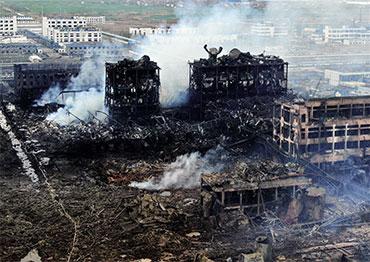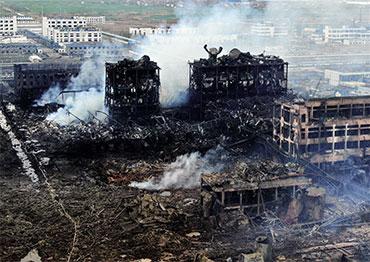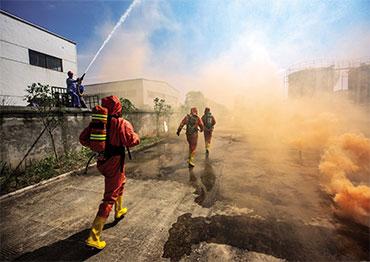Three years after a deadly blast at a chemical plant in Xiangshui County, Jiangsu Province, which killed 78 and injured more than 700 on March 21, 2019, developed coastal areas have increased the pace of regulating or shutting down hazardous chemical enterprises. Many firms have shifted inland, where the investment is welcomed, while experts caution of risks arising due to lax regulations in areas that have little experience in regulating this type of industry.
At a press conference on February 15, Sun Guangyu, director of safety supervision and management of hazardous chemicals at the Ministry of Emergency Management said that hazardous chemical projects have increased the pace at which they are relocating from eastern coastal areas, particularly Jiangsu, Zhejiang and Shandong provinces, to central, western and northeast China, especially since the 2019 accident. He admitted that along with the relocations, accidents are on the rise.
Since 2010, Sun said, the chemical industry in China has been the world’s largest. Current chemical output value in China accounts for more than 40 percent of the world’s total. However, the complex processes and often dangerous chemicals involved are inflammable, explosive, toxic and harmful, posing high safety risks. “If supervision is lax, accidents can easily cause heavy death tolls and property losses,” Sun said.
Li Husheng, an assistant chief engineer at the China Academy of Safety Science and Technology told NewsChina that China has around 96,000 chemical production enterprises, and these include more than 23,000 major sources of hazardous chemicals. Considering storage, transportation, sales and other related derivative enterprises, more than 200,000 enterprises are involved in the production and use of hazardous chemicals. “In terms of the supervision of hazardous chemicals, China has established a relatively comprehensive suite of laws, regulations and standards. But due to the relatively long industrial chains involving components and stages, we are concerned that in the process of project relocation, relaxation of supervision may leave potential safety risks,” Li said.
According to the website of the Institute of Chemistry of the Chinese Academy of Sciences, there are five to eight million chemical products in the world, among which some 100,000 are regularly used. Hazardous chemicals are divided into explosives, compressed gas, liquefied gas and flammable liquids. Common hazardous chemicals include sodium cyanide, potassium cyanide, liquid chlorine, gasoline, acetone, benzene, xylene, ethanol and carbon monoxide.
Li said that from a global perspective, the trend is to relocate manufacturing, including the chemical industry, from developed to underdeveloped regions. From the 1990s to the 2010s, a significant number of hazardous chemical projects were moved from developed countries to developing countries, including China. Hazardous chemical projects need water resources, which China’s eastern coastal areas have in abundance, as well as advantages in capital and human resources. This meant increased investment in the industry. “Now, there is more pressure coming from stricter safety and environmental supervision in eastern China. As they sought to upgrade [their industrial mix], dangerous and polluting projects shifted away. Some central, western and northeastern regions in China welcomed these industries to help local economic development. This is in line with the general trend of industrial development and transfer across the globe,” Li said.
The reduction in the number of chemical companies in eastern China is obvious. According to official statistics, as of 2017 there were more than 5,000 chemical companies in Jiangsu Province with a combined revenue of over 20 trillion yuan (US$3.1t), ranking second in China. In February 2017, Jiangsu started restructuring its chemical industry, proposing to close 2,077 firms by 2018, transfer 272, upgrade 4,327 and restructure 696. Jiangsu wants to have less than 1,000 chemical companies by the end of 2022.
The chemical industry was also an economic pillar in Shandong Province, just to the north of Jiangsu. According to local statistics, by March 2019, there were 2,109 hazardous chemical production enterprises in Shandong, ranking first in China, 85 percent of which are small- and medium-sized enterprises.
In February 2021, then Shandong provincial governor Li Ganjie said that the number of chemical industrial parks in Shandong has gone down from 199 to 84, and over 2,000 chemical enterprises closed or moved.
According to Sun Guangyu, since 2019, 632 chemical industrial projects were relocated inland or to the northeast from eastern China.
Research Director for Cinda Security Zhang Yansheng worked for a chemical company for over a decade. Zhang told news portal The Paper in August 2018 that it is sensible to locate the chemical industry in the lower reaches of rivers, which is common practice not only in China, but in Europe and the US. This does not mean allowing direct wastewater discharges, but it is still the best way to discharge treated wastewater into the sea, since the natural environmental capacity remains very large and it will not have a significant impact on the environment. “The special situation in China is that [some of] the highest population densities are in eastern China where major estuaries are located as well. If the industry is in eastern China, it poses great pressure on the environment there. Moving chemical enterprises from the east seems like a radical move, but there are rational considerations behind the decision,” Zhang said.
In 2021, Jingsheng Digital Economy Industrial Park, the first hazardous chemical digital economy industrial park, opened in Xi’an, northwest China’s Shaanxi Province. The park has room for 500 enterprises. One manager told NewsChina that hazardous chemical projects are moving from developed regions for reasons that include environmental protection requirements, high land prices and industrial structure adjustment. The policies in central, western and northeastern China are comparatively relaxed and may include enticing offers such as rent holidays or tax exemptions. Environmental rules cannot be relaxed, since local officials are appraised on environmental performance in China.
A director of safety supervision for Anqing High-tech Zone in Central China’s Anhui Province told NewsChina that in recent years, the zone, covering an area of 110 square kilometers, has attracted many enterprises from other provinces. “Some chemical entrepreneurs from Jiangsu, Zhejiang and Shanghai came because they are optimistic about the development conditions of Anqing,” the director said.
Sun said at the press briefing that considering the construction cycle of two to three years for hazardous chemical manufacturers, he estimated 470 relocated firms would be in operation by the end of 2022. “Without proper risk control, we might face the challenge of more accidents,” Sun said.
The March 21 accident in Yancheng in 2019 was caused by an explosion of nitrification waste illegally stored in a solid waste warehouse.
Since the accident, coastal provinces have launched chemical industry safety campaigns. According to Sun, in 2021, there were 122 chemical accidents and 150 deaths across the country, down by 15.3 percent and 15.7 percent on 2020, and down by 25.6 percent and 45.3 percent on 2019.
However, moving enterprises may pose additional risks. On January 5, 2022, the Work Safety Committee of the State Council issued the National Hazardous Chemical Safety Risk Comprehensive Treatment Plan, which stated that hazardous chemicals involve a wide range of industries, and its long production chain and high-risk potential will require enhanced governance measures. The safety risks of chemical industry transfers are accelerating in some regions that lack the ability to prevent them. According to official statistics, seven out of the 12 major chemical accidents in recent years took place in enterprises that moved from coastal to inland provinces.
Apart from preparatory measures and procedures ahead of the transfer, according to industry insiders, a significant number of chemical company accidents occur in the emergency response stage, which shows a lack of internal training for first responders in companies.
Qi Yuchun, an expert from the China Chemical Safety Association said their investigations reveal that many cases of fatal exposure to toxic chemicals involved the deaths of three or more people. A common scenario is that one person is affected, but then the rescuers are exposed too. Many die or get sick due to improper protection and handling measures. “It shows the importance of improving the competency of employees in these industries,” Qi told NewsChina.
In January, chief engineer of the China Chemical Safety Association Cheng Changjin said in a speech that among nine chemical industry accidents in 2021 involving 39 deaths, six occurred in maintenance operations, and three involved procedures in emergency handling, or loading and unloading vehicles.
Qi Yuchun believes that based on the data already collected, accidents in the production process are relatively rare under the present regulation and supervision system. Therefore to lower the accident rate, more attention should be paid to human factors, especially improved training at new sites of relocated plants. Many inland regions are relatively underdeveloped and less attractive to professionals. When chemical industry projects move, most employees do not follow. “This inevitably means there won’t be enough professional employees for the relocated chemical enterprises,” Qi said.
Pei Wentian, director general of the safety foundation department with the Ministry of Emergency Management, said at a press conference in 2019 that among the 18 million employees involved in dangerous chemicals, coal, mining, metal smelting and fireworks production, 34 percent have only attained a junior high school education, and many are lower than that. Only 20 percent have attended formal vocational training programs.
On December 31, 2021, the Safety Committee of the State Council issued the National Management Plan for Hazardous Chemicals, which said that there are some major safety risks in chemical industrial parks, including improper zoning of hazardous enterprises in populated areas, substandard management and lack of well-trained safety management personnel.
To head off these issues, some provinces have released plans. On December 15, 2021, Anhui Provincial Department of Emergency Management issued the “Implementation Plan of Hazardous Chemical Industry Transfer Project and Chemical Industry Safety Risk Prevention and Control,” which targets all projects that have moved since 2016. All projects must have undergone a full review by the end of 2022. Other provinces including Shanxi, Sichuan and Heilongjiang have said they will improve standards and management at relocated enterprises.
Sun Guangyu said that the Ministry of Emergency Management would launch a year-long rectification and governance program across 21 provinces in central, western and northeastern China in the chemical industry. Measures include increasing the threshold for approving relocated projects by listing stricter access regulations to curtail the number of relocating enterprises, regulating and managing existing chemical projects to improve safety, and upgrading industrial parks’ safety risk management capability.
Sun added that so far, the ministry has selected 50 key counties for the campaign to serve as an example for other areas. In the past two years, experts have been sent to guide the deployment of safety measures in those counties, and would continue to do so this year, Sun said.
“Local areas should take the opportunity of transferring these chemical projects to improve their safety control quality through enhanced technology. Rather than just a geographical shift, these relocated projects should avoid transferring risks from the east to other regions,” noted Chen Danjiang, a chemical industry expert in an interview with China Energy News in March.

 Old Version
Old Version

